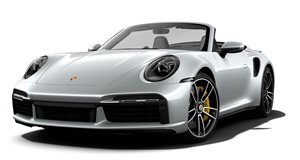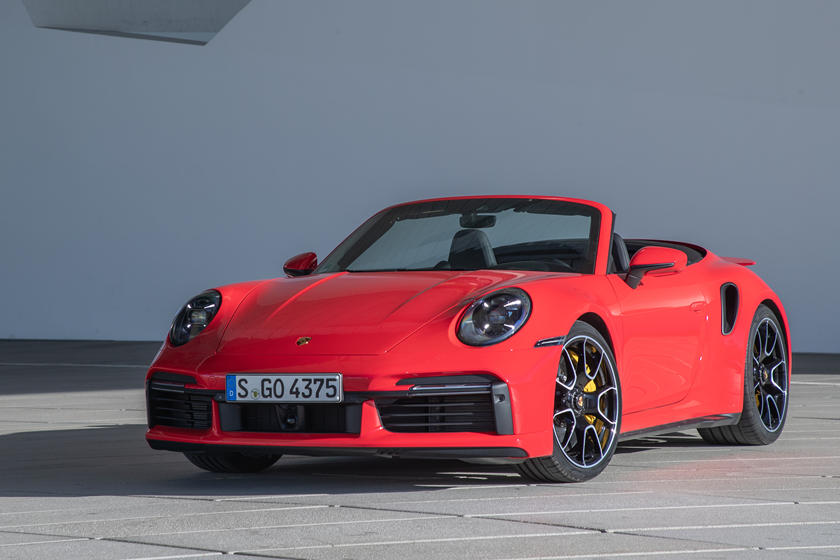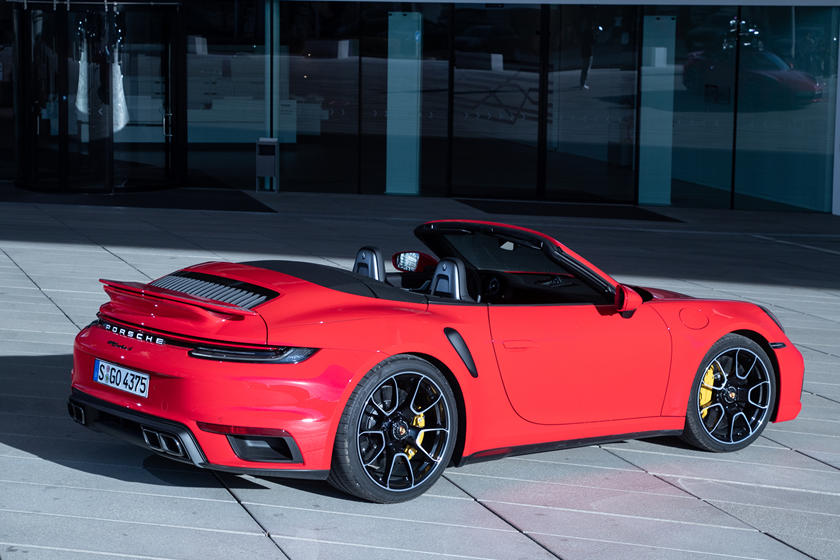
In the motoring world, few numbers represent performance and cutting edge technology as well as the hallowed 911. The Porsche 911 is an absolute icon of the sports car universe, and with good reason - it offers class-leading performance, time after time. For 2021, Porsche upped the ante with its new range of 911 Turbo models, including the 911 Turbo and Turbo S Cabriolets, which gained more power while losing their roofs. The Porsche 911 Turbo Cabriolet features a twin-turbocharged 3.8-liter flat-six engine with power levels of up to 640 horsepower, as well as a dual-clutch transmission. Competing with the car are the likes of the Mercedes-AMG GT R Roadster, Audi R8 Spyder, and the Lamborghini Huracán Evo Spyder. While the 911 Turbo Cabriolet might not be the most lethal weapon in Porsche's arsenal, it should prove to be one of the most satisfying to live with.
While new models are introduced elsewhere in the 911 range, the Turbo Cabriolet remains mostly as is for the 2022 model year. The Porsche Communication Management (PCM) system is updated to the latest version of the software and the wireless Apple CarPlay is finally joined by Android Auto - although it still requires a cable. A new Remote Park Assist function is also now optionally available.
See trim levels and configurations:
| Trim | Engine | Transmission | Drivetrain | Price (MSRP) |
|---|---|---|---|---|
| Turbo Cabriolet |
3.8L Twin-Turbo Flat 6 Gas
|
8-Speed Automatic
|
All-Wheel Drive
|
$187,100 |
| Turbo S Cabriolet |
3.8L Twin-Turbo Flat 6 Gas
|
8-Speed Automatic
|
All-Wheel Drive
|
$219,800 |
The Porsche 911 Turbo Cabriolet takes an evolutionary approach to its exterior design changes, and only those in the know will be able to spot any significant differences between 2019 and 2021 models (there was no 2020 model year) - while the 2022 model receives no exterior changes. Significant exterior changes over the previous 991 generation include a 0.8-inch wider stance with a flared rear end which hides a set of standard double five-spoke alloy wheels (20 inches up front, 21 inches at the rear), and the inclusion of standard LED headlights (LED matrix headlights on the Turbo S), amongst others. The fold-up roof disappears underneath an iconic ducktail-style rear wing.
The 2022 911 Turbo Cabriolet measures in with a total length of 178.6 inches and rolls on a 96.5-inch wheelbase. With the wing mirrors folded in, the Cabriolet has a width of 74.9 inches and is 51.3 inches tall, while 4.8 inches of girth is added by extending the wing mirrors. Front and rear tracks come in at 62.4 inches and 63 inches, respectively, and curb weight is a reasonable 3,790 pounds.
Porsche joins the great horsepower race with the new 911 Turbo: the non-S Turbo produces 572 horsepower and 553 lb-ft of torque while the 911 Turbo S Cabriolet delivers a gut-wrenching 640 hp and 590 lb-ft from its twin-turbocharged 3.8-liter boxer six motor. That is a power increase of 60 hp and 37 lb-ft of torque over the 911.2 Turbo S (when the latter is in overboost), which translates into a zero to sixty sprint time of only 2.7 seconds and a 205 mph top speed. The Turbo is barely slower, getting to 60 in 2.8 seconds and reaching a top speed of 199 mph. Power is sent to all four wheels via an eight-speed PDK transmission.
Not only is the new 911 Turbo Cabriolet faster in a straight line, but Porsche has spent its time honing the cornering capabilities of the new car up to a point where handling feels noticeably improved. How did they manage that? Well, firstly, there's the introduction of a refined active suspension management sport system that allows the 911 Turbo Cabriolet to be lowered by 0.39 inches. You also get dynamic chassis control and rear-axle steering. Bringing everything to a controlled stop is a set of 16-inch front rotors on the Turbo. The Turbo S has 16.5-inch front rotors and standard Porsche Ceramic Composite Brakes (PCCB). Refined when you need it to be, and capable of dismantling curves at speed when you ask - it's the consummate all-rounder.
The gas mileage figures released by the EPA for the 2022 model are 15/20/17 mpg city/highway/combined for both the Turbo and Turbo S. Fuel capacity sits at 17.6 gallons, which should give the car a maximum range of only around 300 miles.
Figures don't vary much from the current 911 Turbo Coupe, which means that those seated in front get a much better deal than anyone at the back. You still get four seats with enough room to fit two large adults in the front, but the rear seats should be considered as extra storage space, or at a push, can be used to cart around children. The seating position on the 911 has been historically good, and with electronically adjustable everything, we see no reason why drivers of all sizes shouldn't be able to find the perfect driving position.
You won't be able to carry enough luggage for a family of four, but the 2021 Porsche 911 Turbo Cabriolet does offer some useful trunk and cargo space. In the front luggage compartment, you get 4.5 cubic feet of luggage space, which is enough for two small carry-on suitcases, and with the rear seats folded, you get a solid 9.3 cubic feet of space, making this a practical two-seater sports car. Inside the cabin, you get tight door pockets, a center console storage shelf with cupholders, and a glove box for storing smaller items.
Porsche likes to keep most of its premium features on the options list, but this doesn't mean that the 2022 Porsche 911 Turbo Cabriolet comes with only a handful of premium features. Both versions of the 911 Turbo Cabriolet have heated front seats, cruise control, keyless entry, a rearview camera, front/rear ParkAssist, and the availability of a surround-view camera system. However, where the Turbo has 14-way powered front seats, the Turbo S gets 18-way powered adaptive sport seats. Standard driver assistance tech includes high-beam assist and forward-collision warning, while performance features like adaptive suspension, the Sport Chrono package, and rear-axle steering also feature as standard.
If you're not into the sound produced by that twin-turbo flat-six engine, then you can always get the infotainment system up and running, and in the case of the 911 Turbo Cabriolet, you get a pretty good deal: there's a 10.9-inch touchscreen with a 12-speaker Bose sound system which includes 12 amplifier channels and a 100-watt subwoofer. Standard features include a Wi-Fi hotspot, SiriusXM satellite radio, Bluetooth streaming, wireless Apple CarPlay integration, and, from this year, Android Auto - although you still require a cable for it. For those in the mood for some extra loud Boney M, Porsche offers an optional 13-speaker Burmester sound system.
The 2022 Porsche 911 Turbo Cabriolet is only just now hitting the road, so there was no recall history at the time of writing. However, last year's model was recalled twice - once for a passenger seat that might interfere with the passenger's airbag deployment and once for suspension components that might not have been properly fastened. The 911 Turbo is covered by a four-year/50,000-mile basic warranty, a 12-year corrosion protection warranty, and a two-year warranty for genuine Porsche parts, exchange parts and accessories.
There is a large number of standard, and optional active driver assistance features onboard the 2022 Porsche 911 Turbo Cabriolet, but your standard safety equipment includes front and side airbags, a sport-tuned traction and stability program, as well as automatically deploying supplemental safety bars. Driver assistance features include forward collision avoidance, Park Assist front and rear, a rearview camera, cruise control, as well as high-beam assist for the LED headlights. Despite the fact that neither the NHTSA nor IIHS has reviewed the 911 in any form, we expect it to maintain the highest safety standards.
The evolution of the 911 spans over half a century and has only improved with time. The current 911 Turbo is one of the best all-round supercars on offer and delivers on both performance and comfort. It is more powerful than ever before, with hardly any drop in performance relative to its hardtop counterpart, and offers increased handling capabilities that should see it leave competitors such as the Mercedes-AMG GT S in the dust. The fact that there are GT3s and that GT2 RSs will be coming too is simply frightening; the 911 Turbo Cabriolet, whether in S guise or not, is already an open-top roadster treading on supercar toes.
The Porsche 911 Turbo Cabriolet is the most expensive convertible Porsche you can buy right now. At $187,100, the Turbo Cabriolet is almost $13,000 more expensive than its hardtop sibling. Even pricier is the Turbo S Cabriolet which carries an eye-watering MSRP of $219,800.
This excludes registration, tax, and a destination fee of $1,350. To put that into perspective, the 2022 Mercedes-AMG GT C Roadster will set you back $165,100.
There are only two models to choose from: the 911 Turbo Cabriolet and the even more potent 911 Turbo S Cabriolet. For $32,700 more, the Turbo S will get to 60 mph in a tenth of a second faster and climb past the magic 200-mph mark. It also has extras like matrix LED headlights and Porsche Ceramic Composite Brakes (PCCB), which is especially useful if you intend driving your 911 hard on track. At these prices, what's another 30 grand or so, right? For that reason, we'd want the all-conquering Turbo S. We'd opt for a vivid color like Racing Yellow and get the $3,490 Sport Exhaust System. To cover safety and convenience, add a surround-view camera ($1,430) and adaptive cruise control ($2,000) and you're all set for the sum of $228,070 including destination.
| Competitor | Horsepower | MPG | Price (MSRP) |
|---|---|---|---|
| Porsche 911 Turbo Cabriolet | 572 hp | 15/20 mpg | $187,100 |
| Audi R8 Spyder | 602 hp | 13/19 mpg | $160,900 |
| Mercedes-AMG GT Roadster | 523 hp | 15/20 mpg | $130,700 |
The 2022 Audi R8 Spyder V10 Performance is one of the few supercars out there that still makes use of a high capacity naturally aspirated engine. The 5.2-liter V10 engine under the engine cover produces 532 hp and 398 lb-ft of torque and gets this Audi to sixty in 3.7 seconds. We like its sharp new looks and that awesome V10 howl. It's also one of the easier drop-top supercars to live with and comes with Audi's brilliant build quality. It's a heavy drinker, however, and isn't the sharpest or most engaging car to drive in this class. We'd still go with the Porsche, which is vastly more capable in all scenarios, much faster, and has rear seats, despite the fact that it's missing the sensual V10 howl.
The 2021 Mercedes-AMG GT C Roadster is one serious piece of German engineering and is powered by a 4.0-liter twin-turbo V8 engine producing 550 hp and 502 lb-ft of torque. The GT R Roadster that closely approximated the Porsche in terms of price is no longer available. Unlike the 911 Turbo Cabriolet, the GT R used to be focused on track use, which meant harsh suspension and a nine-stage stability control system to allow varying amounts of slip. The GT C is not that hardcore though - and slower. The AWD 911 is competent both on road and on track, and it has a different demeanor. You get the 911 Turbo for the duality and its ability to do all things with style and grace, but with the AMG GT R gone - which would have been the car you would buy for the experience of a snarling V8 and a chassis that bludgeons corners into submission - the GT C does not offer a compelling argument over the Porker.
The most popular competitors of 2022 Porsche 911 Turbo Cabriolet:






